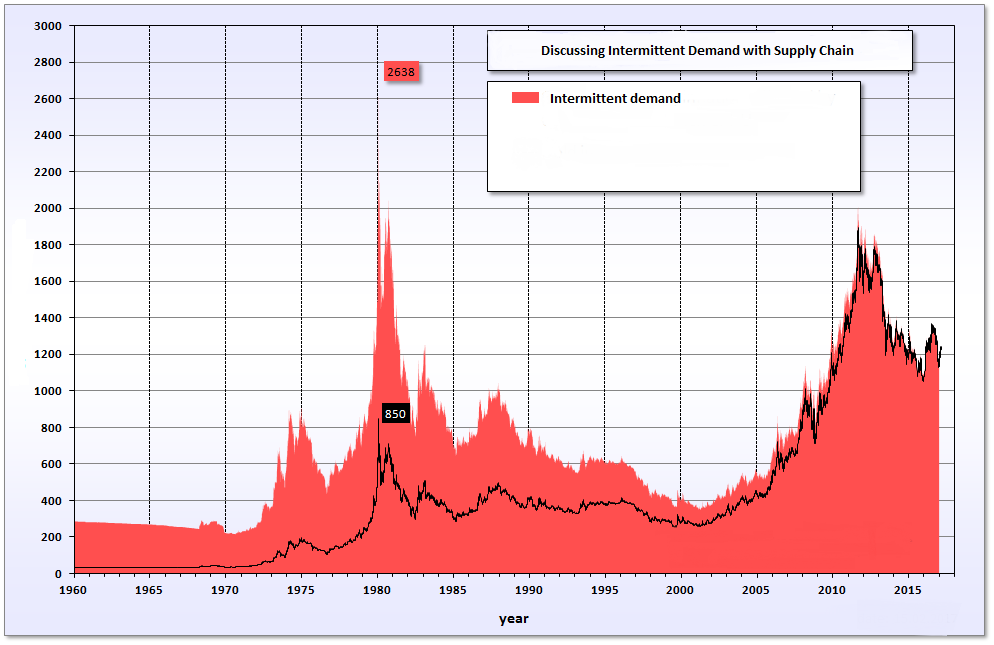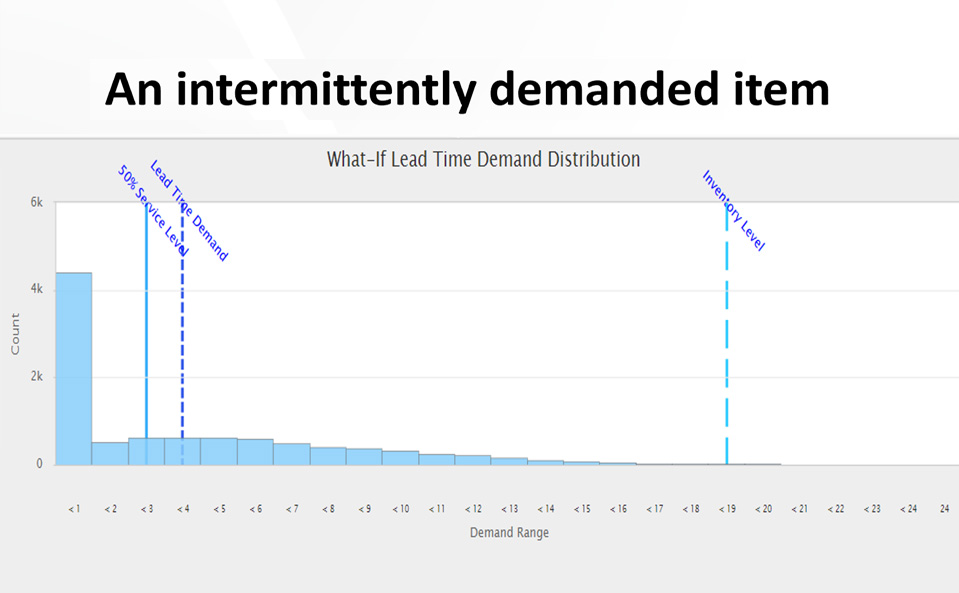A fundamental aspect of supply chain management is accurate demand forecasting. Some product items have an intermittent demand pattern that makes them all but impossible to forecast with traditional, smoothing-based forecasting methods. We address the problem of forecasting intermittent demand (or irregular demand), i.e. random demand with a large proportion of zero values. This pattern is characteristic of demand for companies that manage large inventories of service and spare parts in industries such as aviation, aerospace, automotive, high tech, and electronics, as well as in MRO (Maintenance, Repair and Overhaul).
Accurate forecasting of demand is important in inventory control, but the intermittent nature of demand makes forecasting especially difficult for service parts planning. Similar problems arise when an organization manufactures slow-moving items and requires sales forecasts for planning purposes. Because forecasts of intermittent and lumpy demand have been so unreliable, most companies forecast inventory requirements relying primarily on subjective business knowledge, forecast only a fraction of their higher volume inventory, use simple “rule of thumb” estimates, or traditional statistical forecasting that incorrectly assumes a particular type demand distribution for inventory control.
Learn industry best practices on how to improve intermittent demand forecasting and create supply chain efficiencies in the articles below.

The Scourge of Skewness
Demand planners have to cope with multiple problems to get their job done. One is the Irritation of Intermittency. The “now you see it, now you don’t” character of intermittent demand, with its heavy mix of zero values, forces the use of advanced statistical methods, such as Smart Software’s patented Markov Bootstrap algorithm. But even within the dark realm of intermittent demand, there are degrees of difficulty: planners must further cope with the potentially costly Scourge of Skewness.

6 Essential Steps to Better Recovery Planning
As we approach the midpoint in 2013, there is still a lot of economic uncertainty complicating your supply chain planning processes. Some look at this shaky economy and postpone needed investments that can position their organizations for a strong future.

A CFO’s Perspective on Demand Planning – “More Strategic Than You Think”
NKK Switches, based in Scottsdale, Arizona, is a leading manufacturer and supplier of electromechanical switches. The business involves many different switch types—toggles, push-button, rotary, even some programmable switch types. We are known for our high quality, and for our ability to meet an exceptionally broad range of customer requirements on a turnkey (custom configuration) basis. NKK Switches produces customized solutions from component parts sourced exclusively from manufacturing facilities in Japan and China.

Discussing Intermittent Demand with Supply Chain Brain’s Bowman
The unique challenges of inventory planning for spare parts, large capital goods and other infrequently or irregularly moving items drives the importance of finding smarter methods to forecast this kind of intermittent demand. Robert Bowman, Editor of Supply Chain Brain Magazine, and I discussed this topic at the October APICS conference in Denver, and video of our conversation is available at Supply Chain Brain‘s website.

Lessons From Superstorm Sandy
The destructive impact of Hurricane Sandy has been both staggering and instructive. Our thoughts and best wishes for rapid recovery go out to all who have suffered personal or economic loss or damage. Now, in Sandy’s aftermath, we find ourselves thinking about accelerating recovery and planning for the next unforeseen event.
The Problem
Some product items have an intermittent demand pattern that makes them all but impossible to forecast with traditional, smoothing-based forecasting methods. Items with intermittent demand – also known as lumpy, volatile, variable or unpredictable demand – have many zero or low volume values interspersed with random spikes of demand that are often many times larger than the average. This problem is especially prevalent in companies that manage large inventories of service and spare parts in industries such as aviation, aerospace, automotive, high tech, and electronics, as well as in MRO (Maintenance, Repair and Overhaul).
Intermittent demand
In these businesses, as much as 80% of the parts and product items may have intermittent or lumpy demand. Intermittent demand makes it difficult to accurately estimate the safety stock and service level inventory requirements needed for successful supply chain planning. Because forecasts of intermittent and lumpy demand have been so unreliable, most companies forecast inventory requirements relying primarily on subjective business knowledge, forecast only a fraction of their higher volume inventory, use simple “rule of thumb” estimates, or traditional statistical forecasting that incorrectly assumes a particular type demand distribution for inventory control. The result is that billions of dollars are wasted every year because of either excess inventory costs or poor customer service due to stock-outs.
Intermittent demand – also known as lumpy, volatile, variable or unpredictable demand.
The Smart Solution
SmartForecasts and Smart Inventory Optimization use a unique empirical probabilistic forecasting approach that results in accurate forecasts of inventory requirements where demand is intermittent. The solution works particularly well whenever demand does not conform to a simple normal distribution. Our patented, APICS award-winning “bootstrapping” technology rapidly generates tens of thousands of possible scenarios of future demand sequences and cumulative demand values over an item’s lead time. These scenarios are statistically similar to the item’s observed data, and they capture the relevant details of intermittent demand without relying on the assumptions commonly made about the nature of demand distributions by traditional forecasting methods. The result is a highly accurate forecast of the entire distribution of cumulative demand over an item’s full lead time. With the information these demand distributions provide, you can easily plan your company’s safety stock and service level inventory requirements for thousands of intermittently demanded items with nearly 100% accuracy.
The Benefits
Companies using our powerful intermittent demand forecasting and planning solution typically reduce standing inventory by 20% in the first year, increase parts availability 10-20%, and reduce the need for and associated costs of emergency transshipment to close gaps in their supply chain. Repair and service parts inventories are truly optimized, leading to more efficient operations, improvements in customer service, and significantly less cash tied up in inventory.
White Paper: Smart Software Gen2
In this white paper, we introduce “Gen2”, our next generation of probabilistic modeling technology that powers the Smart IP&O Platform. We recount the evolution of Smart Software’s forecasting methods and we detail how Gen2 substantially expands the capabilities that have made Gen1 so useful to so many companies. Finally, we will also give a high-level view of the probability math behind Gen2 . Fill in this form and we'll email you the paper.










